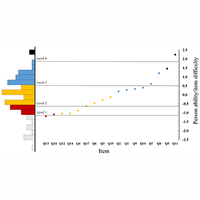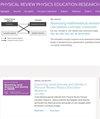Assessment of preservice physics teachers’ knowledge of student understanding of force and motion
IF 2.6
2区 教育学
Q1 EDUCATION & EDUCATIONAL RESEARCH
Physical Review Physics Education Research
Pub Date : 2024-05-31
DOI:10.1103/physrevphyseducres.20.010148
引用次数: 0
Abstract
In physics education, a number of studies have developed assessments of teachers’ knowledge of student understanding (KSU) of specific physics concepts with modified versions of existing concept inventories, in which teachers were asked to predict the popular incorrect answers from students. The results provide useful but indirect information to make inferences about teachers’ knowledge of the misconceptions that students may be using in answering the questions. To improve the assessment of teachers’ KSU, a new instrument is developed using a three-tier item design. The items were adapted from 17 questions from the Force Concept Inventory on force and motion. Each item was designed in three tiers, with tier 1 asking for teachers’ own answers to the question to test their content knowledge, tier 2 asking for teachers’ predictions of popular students’ incorrect answers, and tier 3 asking for teachers’ explanations of students’ incorrect answers in an open-ended form. The three-tier design captures teachers’ content knowledge, predictions, and explanations in a single item to allow explicit measures of teachers’ own content knowledge and their KSU on students’ misconceptions. The instrument was validated with preservice physics teachers, who were master-level graduate students in a normal university in China. The assessment results also suggest that the preservice teachers’ KSU of force and motion was only moderately developed, and their content knowledge was uncorrelated with their KSU. In addition, a four-level progression scale of KSU was also developed, which categorized the preservice teachers into five proficiency groups.

评估职前物理教师对学生理解力和运动的掌握情况
在物理教育中,许多研究利用现有概念清单的修订版,对教师对学生理解特定物理概念的知识(KSU)进行了评估,其中要求教师预测学生的常见错误答案。这些结果为推断教师对学生在回答问题时可能使用的错误概念的了解提供了有用但间接的信息。为了改进对教师 KSU 的评估,我们开发了一种采用三层题目设计的新工具。这些题目改编自力概念量表中有关力和运动的 17 个问题。每个项目均设计为三层,第一层要求教师自己回答问题,以测试其内容知识;第二层要求教师预测学生的错误答案;第三层要求教师以开放式形式解释学生的错误答案。三层设计将教师的内容知识、预测和解释包含在一个项目中,以便明确测量教师自身的内容知识和他们对学生错误认知的 KSU。该工具在中国一所普通高校的硕士研究生职前物理教师中进行了验证。评估结果还表明,职前教师对力和运动的 KSU 仅有中等程度的发展,他们的内容知识与其 KSU 不相关。此外,还建立了四级 KSU 进阶量表,将职前教师分为五个能力组别。
本文章由计算机程序翻译,如有差异,请以英文原文为准。
求助全文
约1分钟内获得全文
求助全文
来源期刊

Physical Review Physics Education Research
Social Sciences-Education
CiteScore
5.70
自引率
41.90%
发文量
84
审稿时长
32 weeks
期刊介绍:
PRPER covers all educational levels, from elementary through graduate education. All topics in experimental and theoretical physics education research are accepted, including, but not limited to:
Educational policy
Instructional strategies, and materials development
Research methodology
Epistemology, attitudes, and beliefs
Learning environment
Scientific reasoning and problem solving
Diversity and inclusion
Learning theory
Student participation
Faculty and teacher professional development
 求助内容:
求助内容: 应助结果提醒方式:
应助结果提醒方式:


